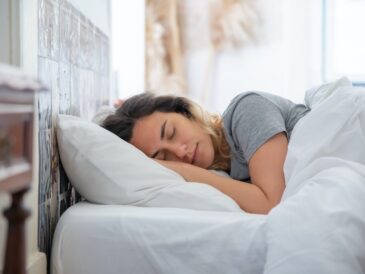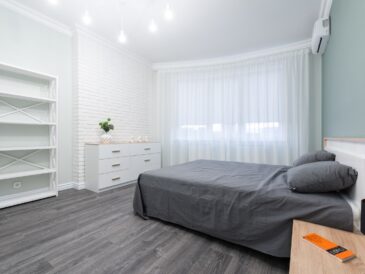Box springs are wooden frames covered with cloth and filled with coils designed to support mattresses. They’re often sold alongside traditional innerspring mattresses as an additional means to elevate bed height, improve airflow around it, and absorb shock absorption.
However, many modern mattresses no longer require box springs; alternatively you could use an alternative foundation without springs inside or even opt for a solid platform bed instead.
Foundation
Box springs are traditional bed bases made of wooden frames covered in fabric with springs inside. They come in multiple sizes from twin to California king and are often sold together as part of a mattress-box spring set. Used with innerspring mattresses, box springs help reduce sagging while providing a solid foundation – and act as shock absorbers and improve airflow that extends mattress longevity.
Box springs may or may not be necessary depending on the kind of mattress and bed you own and how it will be used. Before making a decision on whether or not to use one, always consult your mattress warranty first as some mattresses require specific types of foundation. Some manufacturers like Casper provide their own foundation which works well with foam mattresses – some even advise against the use of box springs as it could damage them!
Mattress foundations are flat bases that sit underneath a mattress to provide support, typically made of wood or metal and measuring the same dimensions as its mattress it will be supporting. In traditional usage, box spring referred to a wooden box containing springs; nowadays however foundations usually consist of sturdy boxes without springs designed solely to support mattresses.
Mattress foundations typically stand 9 inches high, providing an effective means of elevating the mattress for easier entry/exit as well as those who prefer sleeping on an elevated surface. Mattress foundations may be particularly helpful to individuals who find getting in and out of bed difficult or prefer sleeping on higher surfaces.
Alternative mattress foundation options include platform beds (both solid and slatted) or adjustable bases that distribute weight evenly, such as those designed to use with innerspring and memory foam mattresses – so these don’t typically need a box spring.
Height
Most box springs stand approximately 9 inches. This height makes them suitable for many sleepers because it raises their mattress higher off of the floor, making it easier to get in and out of bed, especially those who suffer from back issues or arthritis. Furthermore, having this extra height provides additional benefits if using a footboard with their mattress.
Some mattress companies are creating alternatives to the traditional box spring that don’t require as much extra height. Casper offers their Foundation mattress without needing an additional spring support; Brooklyn Bedding and Tuft & Needle use metal frames with center support similar to traditional spring support but without actual springs.
Standard box springs provide more benefits than just height. Their sturdy construction can prevent mattress sag over time and reduce motion transfer between sleepers – helping improve quality sleep overall.
Box springs provide additional benefits in terms of moisture protection for memory foam mattresses. Their solid structure can absorb some of the impact and damage caused by moisture accumulation on its surface, thus prolonging its lifespan and increasing comfort levels.
Another reason to use a box spring is when recommended by mattress companies. If their warranty specifies it as necessary to safeguard the mattress, it would likely be wiser to follow their advice and purchase a box spring accordingly. Some manufacturers even void warranties if a box spring is not used!
Box springs are necessary for those using traditional mattresses with bed frames, while platform beds with wooden slats rather than solid foundation don’t necessitate one. Furthermore, adjustable power bases for mattresses may serve as suitable replacements in some instances.
Durability
Box springs provide your mattress with a secure foundation while simultaneously improving airflow around it, helping limit mold and dust issues that could trigger allergies or asthma symptoms. Plus, box springs make bed more comfortable by raising it higher while making getting in and out easier.
Box springs are constructed from either wood or metal frames filled with wire coils encased in fabric, and come in various sizes to accommodate traditional mattresses, from twin to king size. Some stylish and affordable options such as Zinus Jayanna Steel BiFold Box Spring are also available, like Amazon Basics Smart Box Spring for instance.
While it is technically possible to use a mattress without a box spring, most people do not advise doing this. Sleeping directly on the floor may cause it to sag over time and make it harder for you to get in and out of bed or find comfortable positions. Furthermore, not having an ample foundation beneath it may limit its lifespan significantly.
Notable mattress-in-a-box brands such as Leesa and Casper warn against using box springs with memory foam and latex mattresses because this could void their warranty; yet many still opt to do so.
Decisions on whether or not to use a box spring are ultimately up to each individual. While some find the extra support and height provided by one advantageous, others prefer saving both space and money by forgoing it entirely.
Notably, modern manufacturers have come up with lightweight boxes without springs that serve as foundations. Alternatively, if you don’t opt for a box spring altogether, your bed frame itself could serve as the basis of your mattress foundation; this option may be helpful if budget restrictions limit how much money can be spent on mattresses.
Comfort
Box springs are intended to provide support and lift for mattresses atop them, while also improving airflow around them and absorbing shock caused by shifts in weight distribution. Available in several sizes for most traditional mattress types like twin, queen and king mattresses – some even come with stylish features such as the Zinus Jayanna Steel BiFold Box Spring shown above! – these springs provide vital assistance.
Even though some new mattresses claim not to require box springs, most manufacturers advise using one to ensure the warranty remains valid and ensure adequate body support is offered by the mattress. Some bed-in-a-box companies such as Leesa and Casper even have specific guidelines about which foundation can be used with memory foam and latex mattresses without invalidating their warranties.
Many sleepers enjoy the added comfort that a box spring provides underneath their mattress. Box springs can add up to 9 inches of height, making it easier for tall people to get in and out of bed more easily, while simultaneously decreasing bugs or other creatures from coming up from underneath during the night.
Apart from offering comfort, box springs also help extend the longevity of mattresses by protecting them against damage and helping prevent sagging along their middle, which may cause body pain.
Box springs can also provide relief for people suffering from back and neck ache. A firm mattress can support natural spinal alignment, helping alleviate symptoms throughout the day.
Interested in understanding why box springs are necessary for mattresses or have any inquiries, reach out to Mattress N More today. Our friendly staff would be more than happy to assist with inventory queries or financing solutions; plus we look forward to finding you your ideal mattress!




